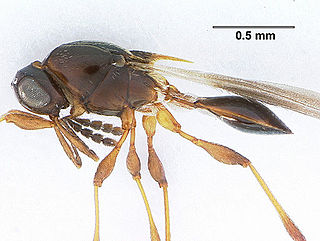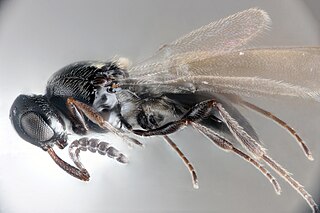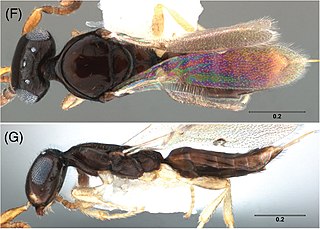
The Hymenopteran superfamily of parasitoid wasps, Platygastroidea, has often been treated as a lineage within the superfamily Proctotrupoidea, but most classifications since 1977 have recognized it as an independent group within the Proctotrupomorpha. It is presently has some 4000 described species. They are exclusively parasitic in nature.

The hymenopteran family Platygastridae is a large group of exclusively parasitoid wasps, mostly very small (1–2 mm), black, and shining, with geniculate (elbowed) antennae that have an eight-segmented flagellum. The wings sometimes lack venation, though they may have slight fringes of setae.

The hymenopteran family Scelionidae is a very large cosmopolitan group of exclusively parasitoid wasps, mostly small (0.5–10 mm), often black, often highly sculptured, with (typically) elbowed antennae that have a 9- or 10-segmented flagellum. It was once considered to be a subfamily of the Platygastridae, but has been revived in the most recent classification of Platygastroidea.

Scelio is a large genus, the largest within the family Scelionidae, of parasitic wasp whose known target host include the eggs of grasshoppers. They are found worldwide and some species have been implemented as biological control agents.
Calliscelio is a parasitoid wasp genus which contains two species, C. elegans and C. teleogrylli.

Telenominae is a subfamily of parasitoid wasps in the family Scelionidae. It was previously considered a subfamily of Platygastridae.
Synopeas is a genus of parasitoid wasps in the family Platygastridae. There are about 400 described species in Synopeas.
Oethecoctonus is a genus of parasitoid wasps in the family Platygastridae. There are about six described species in Oethecoctonus.

Teleasinae is a subfamily of parasitoid wasps in the family Scelionidae. It was previously considered a subfamily of Platygastridae.
Habroteleia is a genus of parasitic wasps in the family Platygastridae. There are about 9 described species in Habroteleia.

Trichacis is a genus of parasitoid wasps in the family Platygastridae. Members of this genus have a tuft of setae on the mesoscutellum and transverse striae or rugulae above the antennae. They are parasitoids of Cecidomyiidae, although the hosts of most species remain unknown.

Idris is a genus of parasitic wasps in the family Platygastridae, containing about 160 described species. This genus is part of the tribe Baeini, which are egg parasitoids. Members of the genus Idris are mostly parasitoids of spider eggs, but at least one member of the genus uses stink bugs as hosts.

Proterosceliopsis is an extinct genus of platygastroid parasitic wasp, known from the Mid-Cretaceous of Eurasia. The genus was first described in 2014 from the Albian amber of the Escucha Formation. In 2019 additional species were described from the Cenomanian-age Burmese amber, and was placed into the monotypic family Proterosceliopsidae.
Isocybus is a genus of parasitoid wasps belonging to the family Platygastridae.
Sparasion is a genus of wasps belonging to the family Sparasionidae, within the superfamily Platygastridae. The genus has specimens widespread in Eurasia, Africa, and temperate North America.

Neuroscelionidae is a family of wasps in the superfamily Platygastroidea. It contains only one extant genus, Neuroscelio, with two other genera known from fossils. Members of Neuroscelio are known from Southeast Asia and Australia. Their hosts are unknown.

Nixonia is a genus of wasps. It is the only member of the family Nixoniidae in the superfamily Platygastroidea. They are amongst the largest of the platygastroids at up to 9 mm in length. Members of the genus are known from Africa, the Indian subcontinent and Southeast Asia. The biology of only one species is known, which parasitizes orthopteran eggs.

Janzenella is a genus of wasp, the only member of the family Janzenellidae within the superfamily Platygastroidea. It contains only a single living species, Janzenella innupta, which has only been collected in Costa Rica. Fossil members of the living species have also been described from Miocene aged Dominican amber. A Late Eocene fossil species, Janzenella theia is known from specimens entombed in Baltic amber.

Geoscelionidae is a family of wasps in the superfamily Platygastroidea. It contains three extant species in two genera, native to South America and Africa, and several other genera known from fossils. It was originally erected as the tribe Geoscelionini within Scelionidae. It was raised to a full family in 2021.

Sparasionidae is a family of wasps in the superfamily Platygastroidea. Known species are parasitoids of the eggs of orthopterans.













